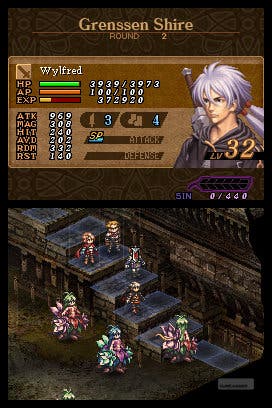Valkyrie Profile: Covenant of the Plume
Light as a feather?
The Valkyrie Profile series has always hidden its quiet inventiveness behind a muted colour palette and melancholic ambiance. In part that’s due to the subject matter. The eponymous Valkyrie is, after all, the Norse personification of Death - scythe replaced by silver saber, black hooded cloak swapped for the blue, white and gold armour of a Scandinavian goddess.
Developer tri-Ace has always cast the player in her role. The task is to usher mortals into the afterlife while their loved ones crumple in mourning on Earth. But for this, the first DS instalment in the series, the roles are reversed. Players assume the role of Wylfred, a young man whose father perished on the battlefield and was carried off by the Valkyrie. The family then fell into poverty and Wylfred's sister died of starvation.
He has become fuelled by existential rage, a bloodlust that will be satisfied only with the death of Death herself. With murder in his heart Wylfred is taken under the wing of another nefarious supernatural being who grants him control of a deadly feather. This tool that can be used to end the life of any of his comrades, and each execution carries the boy one step closer to his improbable quarry. So begins one of the darkest and most remarkable revenge tales ever told in a videogame.
The systems that underpin this cheerless drama are based on the Tactical RPG model. However, as with the previous entries in the series, the framework is reconstructed in a way that often defies genre. Play takes place on small, grid-based environments, player and AI taking turns to move their soldiers around the chess-like battlefield.
But when two warring units engage in battle a separate combat screen is triggered, as in a conventional JRPG, where the warriors fight till their action points are depleted. The workings of the skirmish system will be familiar to players of the earlier Valkyrie profile games. Each unit involved is mapped to a separate DS face button, and by hitting these in time you can unleash a string of attacks on your foe. If you manage to instigate enough attacks to fill a gauge then an impressive Soul Crush move will finish off any foes still clinging to life.

The number of units involved in a skirmish depends on your team members' proximity to each other when the fight is instigated. If the whole team of four characters is within range of an encounter they will be roped in for the fight, with no limit on the number of times this can happen during a turn.
It’s a unique system whose benefit comes from a redoubled emphasis on character placement. The game encourages players to manoeuvre their troops in thoughtful synchronicity, and set-up team sieges over individual scuffles. The downside is that the constant to-ing and fro-ing between battle screen and map screen drags out the length of battle, while pregnant pauses between attack and counterattack rob the game of pace and urgency.
With such a limited party roster, strategy and variety must be found away from multiple character classes. This is done in two ways. Firstly, the titular plume that Wylfred must use in the story to murder teammates is translated from narrative conceit to game system. Any non-player character that can be convinced to join your band of fighters can, at almost any time, be executed in cold blood.

